
Saving Private Ryan is a 1998 American epic war film directed by Steven Spielberg and written by Robert Rodat. Set in 1944 in Normandy, France, during World War II, it follows a group of soldiers, led by Captain John Miller, on a mission to locate Private James Francis Ryan and bring him home safely after his three brothers have been killed in action. The cast also includes Edward Burns, Tom Sizemore, Barry Pepper, Giovanni Ribisi, Vin Diesel, Adam Goldberg and Jeremy Davies.

The Last Picture Show is a 1971 American coming-of-age drama film directed by Peter Bogdanovich and co-written by Bogdanovich and Larry McMurtry, adapted from the 1966 semi-autobiographical novel by McMurtry. The film's ensemble cast includes Timothy Bottoms, Jeff Bridges, Ellen Burstyn, Ben Johnson, Cloris Leachman, and Cybill Shepherd. Set in a small town in northern Texas from November 1951 to October 1952, it is a story of two high school seniors and long-time friends, Sonny Crawford (Bottoms) and Duane Jackson (Bridges).

Battleground is a 1949 American war film directed by William A. Wellman and starring Van Johnson, John Hodiak, Ricardo Montalbán, George Murphy, and James Whitmore. It follows a fictional company of the 327th Glider Infantry Regiment, 101st Airborne Division as they fight in the siege of Bastogne during the Battle of the Bulge, in World War II. The screenplay was written by Robert Pirosh, based on his own experiences during the battle.
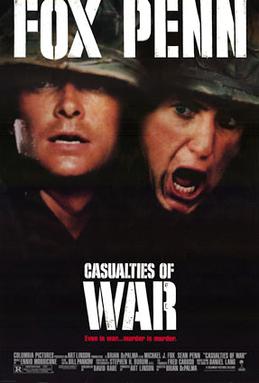
Casualties of War is a 1989 American war drama film directed by Brian De Palma and written by David Rabe, based primarily on an article written by Daniel Lang for The New Yorker in 1969, which was later published as a book. The film stars Michael J. Fox and Sean Penn and is based on the events of the 1966 incident on Hill 192 during the Vietnam War, in which a Vietnamese woman was kidnapped from her village by a squad of American soldiers, who raped and murdered her. For the film, all names and some details of the true story were altered.

Robert Reed Carradine is an American actor. A member of the Carradine family, he made his first appearances on television Western series such as Bonanza and his brother David's TV series, Kung Fu. Carradine's first film role was in the 1972 film The Cowboys, which starred John Wayne and Roscoe Lee Browne. Carradine also portrayed fraternity president Lewis Skolnick in the Revenge of the Nerds series of comedy films.

Targets is a 1968 American crime thriller film directed by Peter Bogdanovich in his theatrical directorial debut, and starring Tim O'Kelly, Boris Karloff, Nancy Hsueh, Bogdanovich, James Brown, Arthur Peterson and Sandy Baron. The film depicts two parallel narratives which converge during the climax: one follows Bobby Thompson, a seemingly ordinary and wholesome young man who embarks on an unprovoked killing spree; the other depicts Byron Orlok, an iconic horror film actor who, disillusioned by real-life violence, is contemplating retirement.
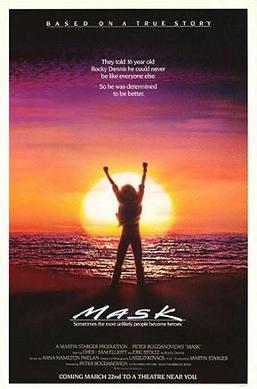
Mask is a 1985 American biographical drama film directed by Peter Bogdanovich, starring Cher, Sam Elliott, and Eric Stoltz with supporting roles played by Dennis Burkley, Laura Dern, Estelle Getty, and Richard Dysart. Cher received the 1985 Cannes Film Festival award for Best Actress. The film is based on the life and early death of Roy L. "Rocky" Dennis, a boy who had craniodiaphyseal dysplasia, an extremely rare genetic disorder known commonly as lionitis due to the disfiguring cranial enlargements that it causes. Mask won the Academy Award for Best Makeup at the 58th ceremony, while Cher and Stoltz received Golden Globe Award nominations for their performances.

Inglourious Basterds is a 2009 black comedy war film written and directed by Quentin Tarantino, starring Brad Pitt, Christoph Waltz, Michael Fassbender, Eli Roth, Diane Kruger, Daniel Brühl, Til Schweiger and Mélanie Laurent. The film tells an alternate history story of two converging plots to assassinate Nazi Germany's leadership at a Paris cinema—one through a British operation largely carried out by a team of Jewish American soldiers led by First Lieutenant Aldo Raine (Pitt), and another by French Jewish cinema proprietor Shosanna Dreyfus (Laurent) who seeks to avenge her murdered family. Both are faced against Hans Landa (Waltz), an SS colonel with a fearsome reputation for hunting Jews.
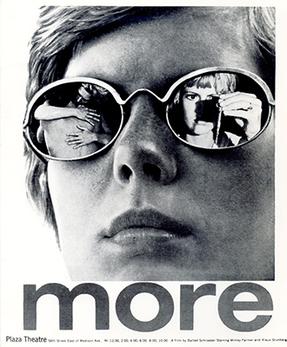
More is a 1969 English-language romantic drama film written and directed by Barbet Schroeder in his directorial debut. Starring Mimsy Farmer and Klaus Grünberg, the film deals with heroin addiction as drug fascination on the island of Ibiza, Spain. Made in the political fallout of the 1960s counterculture, it features drug use, "free love", and other references to contemporary European youth culture.

Samuel Michael "Sam" Fuller was an American film director, screenwriter, novelist, journalist, actor, and World War II veteran known for directing low-budget genre movies with controversial themes, often made outside the conventional studio system. Fuller wrote his first screenplay for Hats Off in 1936, and made his directorial debut with the Western I Shot Jesse James (1949). He would continue to direct several other Westerns and war thrillers throughout the 1950s.

Ballad of a Soldier, is a 1959 Soviet war romance film directed by Grigory Chukhray and starring Vladimir Ivashov and Zhanna Prokhorenko. While set during World War II, Ballad of a Soldier is not primarily a war film. It recounts, within the context of the turmoil of war, various kinds of love: the romantic love of a young couple, the committed love of a married couple, and a mother's love of her child, as a Red Army soldier tries to make it home during a leave, meeting several civilians on his way and falling in love. The film was produced at Mosfilm and won several awards, including the BAFTA Award for Best Film From Any Source and was nominated for an Academy Award for Best Original Screenplay.

Southern Comfort is a 1981 American action-war drama- thriller film directed by Walter Hill and written by Michael Kane, Hill and his longtime collaborator David Giler. It stars Keith Carradine, Powers Boothe, Fred Ward, T. K. Carter, Franklyn Seales and Peter Coyote. The film, set in 1973, features a Louisiana Army National Guard squad of nine from an infantry unit on weekend maneuvers in rural bayou country as they antagonize some local Cajun people and become hunted.

The Steel Helmet is a 1951 American war film directed, written, and produced by Samuel Fuller during the Korean War. The cast stars Gene Evans, Robert Hutton, Steve Brodie, James Edwards, and Richard Loo. It was the first American film about the war and the first of several war films by Fuller.

Louis V. Arco was an Austrian stage and film actor whose career began in the late 1910s.

Merrill's Marauders is a 1962 Technicolor war film, photographed in CinemaScope, and directed and co-written by Samuel Fuller. It is based on the exploits of the long-range penetration jungle warfare unit of the same name in the Burma campaign, culminating in the Siege of Myitkyina.
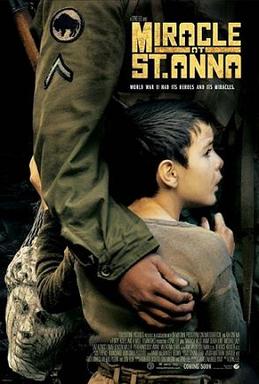
Miracle at St. Anna is a 2008 American–Italian epic war film directed by Spike Lee and written by James McBride, based on McBride's 2003 novel of the same name. The film stars Derek Luke, Michael Ealy, Laz Alonso, Omar Benson Miller, Pierfrancesco Favino and Valentina Cervi, with John Turturro, Joseph Gordon Levitt, John Leguizamo, D.B. Sweeney and Kerry Washington in supporting roles. Set primarily in Italy during the Italian Civil War in World War II, the film tells the story of four Buffalo Soldiers of the 92nd Infantry Division who seek refuge in a small Tuscan village, where they form a bond with the residents. The story is presented as a flashback, as one survivor, Hector Negron (Alonso), reflects upon his experiences in a frame story set in 1980s New York. Several real-life events that occurred during the war, such as the Sant'Anna di Stazzema massacre, are re-enacted, placing Miracle at St. Anna within the genre of historical fiction.
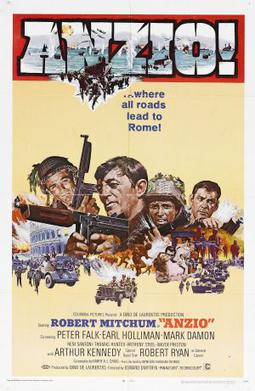
Anzio, also known as The Battle for Anzio, is a 1968 Technicolor war film in Panavision, an Italian and American co-production, about Operation Shingle, the 1944 Allied seaborne assault on the Italian port of Anzio in World War II. It was adapted from the book Anzio by Wynford Vaughan-Thomas, who had been the BBC war correspondent at the battle.
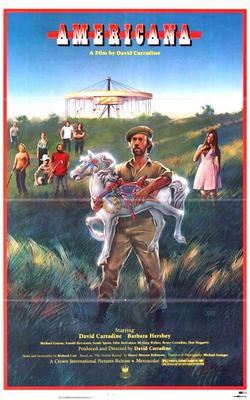
Americana is a 1981 American drama film starring, produced, edited and directed by David Carradine. The screenplay and story, written by Richard Carr, was based on a portion of the 1947 novel, The Perfect Round, by Henry Morton Robinson. The novel's setting was originally post-World War II, but the screenplay involved the post-war experiences of a Vietnam War veteran, obsessed with restoring an abandoned carousel.
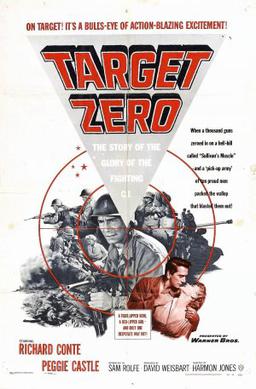
Target Zero is a 1955 American war and drama film directed by Harmon Jones and written by James Warner Bellah and Sam Rolfe.The film stars Richard Conte, Peggie Castle, Charles Bronson, Richard Wyler, L. Q. Jones and Chuck Connors. The film was released and published by Warner Bros. on November 15, 1955.

Our Father is a 2015 British short war drama film written and directed by Calum Rhys. The film stars Luke Goddard, Ross O'Hennessy, Aaron Jeffcoate, Jonas Daniel Alexander and Mark Anthony Games. The film follows a detached British Army section in France during World War II. The film premiered at the 69th Cannes Film Festival.





















